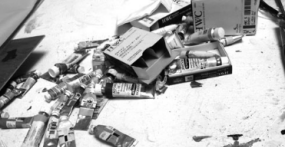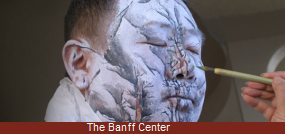
by Bob Martin | Jun 25, 2009 | Art, Creativity, Education, Learning
Call for Artist: Thematic Residencies
01 Master Class: Seven Weeks with the Taskmaster with Kutlu? Ataman
Program dates: January 6 – February 23, 2010
Application deadline: September 14, 2009
Kutlu? Ataman, Turner Prize-nominated artist and film-maker, will lead this unique Master Class designed for young artists who want to break into the international art scene. Instead of teaching art history, art theory, or critical studies, Ataman will encourage ten participants through weekly group and one-on-one discussions to work through impasses, develop new studio practices, and bring their ideas to fruition.
08 Polymath Breakthrough with Joseph del Pesco
Residency Dates: November 16 – December 11, 2009
Application Deadline: July 15, 2009
This residency is designed to bring artists and their collaborators together to experimentally work toward big ideas. Existing collaborative pairs of artists and professionals from disciplines outside the arts will participate in an intensive series of think-tank style discussions and give presentations on research topics to exchange their collective and creative intelligence.

by Bob Martin | Jun 15, 2009 | Art, Artist, Creativity, Galleries
ARTISTS’ CALL ANNOUNCEMENT OPEN CALL FOR JURIED EXHIBITION ,PITZER ART GALLERIES, PITZER COLLEGE
GUEST JUROR: DANIEL JOSEPH MARTINEZ
Deadline: July 20, 2009
Pitzer Art Galleries,1050 North Mills Ave., Claremont, CA 91711
Director, Ciara Ennis
Email, CapinQuestArt@Pitzer.Edu
Web site, http://www.pitzer.edu/artgalleries
Tues.-Fri., 12-5pm
The Center for Social Inquiry at Pitzer College and the Pitzer Art Galleries are pleased to announce an open call for art works addressing the broad theme of “CAPITALISM IN QUESTION (because it is).”
The rampant capitalism of the last decade, and its recent catastrophic crisis, has left us in a peculiar and unfamiliar space. Capitalist economic ideology and practices are suddenly under renewed scrutiny.
“CAPITALISM IN QUESTION (because it is)” invites artists to explore our current economic predicament and to consider a range of alternatives to it. Visual artwork in all media-painting, installation, sculpture and photography-is encouraged.
All materials for consideration should be submitted by 7/20/2009 to Ciara Ennis.
During the 2009-2010 academic year, the Center for Social Inquiry at Pitzer College will be sponsoring a series of lectures and seminars that re-open questions about capitalism and its discontents-rather than treating capitalism, or “markets,” as the all-purpose answer to social questions, as has been increasingly common since the 1980s in both American society and the larger global economy. This thematic inquiry will look backward in time to examine the most recent and earlier “busts” following capitalist “booms,” and will look forward in time to consider the range of forms, both desirable and undesirable, that might emerge when the global capitalist economy “recovers” from its current collapse.
In conjunction with this program of lectures and seminars, the Center for Social Inquiry and the Pitzer Art Galleries are together issuing a call for works of art that examine and represent various moments of capitalism and its discontents, as well as the possible futures following our own moment of crisis, for exhibition at the Pitzer Art Galleries staring in January of 2010.
One aspect of this broad thematic topic that might be explored in such works is the relations, extending either in time or in space, between capitalist prosperity and capitalist discontents. Start, for example, at any physical site of prosperity and select a profitable consumer good-coffee, let us say-and follow the labor chain behind that good, across various borders and geographic formations (or across the often subtle barriers between urban neighborhoods). As a rule, sooner or later, you will find some workers who were intensely exploited in the production of that good. To quote from the March 2009 Gourmet magazine: “If you have eaten a tomato this winter, chances are very good that it was picked by a person who lives in virtual slavery.” In response to this stark observation (taken from a publication that is more likely to aestheticize than politicize food), we seek art works that provide new perspectives on these spatial relations and-of equal importance-on the social forces and practices that keep these relations out of our ordinary sight.
Alternatively, start at a moment of prosperity-Autumn 2006, let us say-and move forward in time. As a rule, at some point moving into the future, you will observe a fantastic economic collapse and evaporation of money-wealth. One could equally well pick February 1637 as Autumn 2006-and then move forward in time to observe the fantastic collapse and evaporation of all of the wealth invested in tulips, rather than houses. Or-to provide a second example of the way the discontents of capitalism are to be found in future moments-one can think about the ways capitalist enterprises, at least since the industrial revolution, have never taken responsibility for environmental damage in real time, but have instead left the costs of such destruction for future generations to bear. Here again, we are interested in art that probes and re-visions these relations across time, that is, these relations between moments that are past and future to each other.
An additional set of questions is also suggested at this juncture. If the discontents of capitalism are typically some where or some time else-that is, some where or some time other than at sites of capitalist prosperity-what is it instead that we find at such sites? What characteristics does their emptiness (of these discontents) possess? What fantasies exist at such sites, about the absence or defeat of capitalism’s discontents? What, in other words, are the fantasies of “financial experts,” the “captains of the universe” and others of their ilk? Here again, we are interested in works of art that explore these complex questions, in whatever ways.
Finally, if we look forward in time from our moment of crisis (rather than from moments of prosperity), we can see in front of us a broad horizon of possible futures, stretching from the dystopian to the utopian and from the fantastic to the banal. Our call for art includes, as well, a call for works that explore and speculate about such futures, relative to our own the troubled moment that is our present.
There are, of course, other dimensions to capitalism and its discontents, beyond those we have suggested. We provide these questions and observations only as starting points-that is, as initial provocations to be taken, we hope, in myriad directions.
About Pitzer College
Pitzer College is a nationally top-ranked undergraduate college of the liberal arts and sciences. A member of The Claremont Colleges, Pitzer offers a distinctive approach to a liberal education by emphasizing interdisciplinary studies, intercultural understanding, and social responsibility.
About The Center for Social Inquiry at Pitzer College
Founded in 2008, the Center for Social Inquiry at Pitzer College operates both a public events series that extends over the full academic year and, in the spring semester, an advanced seminar in social inquiry for up to 22 highly qualified undergraduates from the Claremont Colleges. In keeping with Pitzer College’s pursuit of interdisciplinary learning and public inquiry, the Center’s public events series features public intellectuals and artists, as well as scholars in the humanities, sciences, and social and behavioral sciences. The Center is directed by Daniel Segal, the Jean M. Pitzer Professor of Anthropology and Historical Studies. For 2009-2010, the Center’s thematic focus is “CAPITALISM IN QUESTION (because it is).”
About Pitzer Art Galleries
Pitzer Art Galleries exists to provide visually arresting and memorable exhibitions that promote the value and understanding of contemporary art within a local, national, and international context. The Galleries are comprised of two sites, the Nichols Gallery-committed to solo and group exhibitions by national and international artists both emerging and established-and the Lenzner Family Art Gallery-a space for risk and experimentation dedicated to emerging artists working in all media. Through curatorial creativity and visionary programming, Pitzer Art Galleries seeks to provide context, support, and a critical framework for artists and curators working today and, by doing so, inspire meaningful dialogue that fascinates and invigorates. The Pitzer Art Galleries are directed by Ciara Ennis.
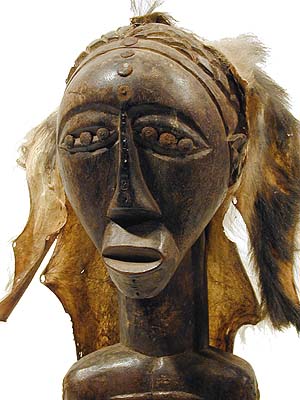
by Sandy | Jun 9, 2009 | Art, Blogroll, Creativity, Culture, Exhibits, Museums
Starting June 20, the deYoung Museum of San Francisco will have over 50 masks and sculptures from 4 Central African cultures, Luba, Chokwe, Songye (fetish figures) and Luluwa. Even though the 4 groups are different, they did share common beliefs. The pieces, fashioned mostly of wood with brass and bead touches, were made to appease the spirits and were thought to have the power to protect an individual from harm.
According to the museum catalog, the exhibit “examines the artistic traditions of the heart of Africa within the
context of historical change, thus countering the commonly held perception of African art as an art without history. “
“Art and Power in the Central African Savanna” 6/20 – 10/11/09
de Young Museum, Golden Gate Park, San Francisco, CA
Images:
1- “Luba” – wood, beads, brass
2- “Chibinda IIunga”, Chokwe, Angola, West Africa
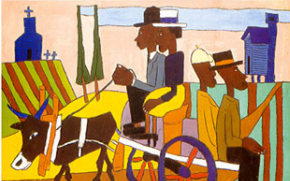
by Bob Martin | May 28, 2009 | Art, Artist, Creativity, Photograhy, sculptor, Writing and Speaking
Applications for the 2009 William H. Johnson Prize are now available online at http://www.whjohnsongrant.org
Please note that the due date for all applications is July 31, 2009, several months earlier than in past years. Applicants are advised to take note of the change so that they do not miss the deadline. The 2009 William H. Johnson Prize is 25,000 USD and the winner will be announced in September 2009.

William Johnson Self Portrait
The William H. Johnson Foundation for the Arts is a nonprofit, tax-exempt organization that seeks to encourage African American artists early in their careers through its annual award, The William H. Johnson Prize. Early career African American artists who work in painting, photography, sculpture, printmaking, installation and/or new genre are eligible to apply.
William H. Johnson, an African American artist born in Florence, South Carolina in 1901, is the namesake of the Foundation. He moved to New York as a young man to study at the National Academy of Design, and though he was acknowledged as the most talented artist in his class of 1926, he was passed over for a traveling scholarship, most likely because of his race. Rather than see Johnson struggle in the United States, his teacher, Charles Hawthorne, gave Johnson 1000 USD so that Johnson could travel to Europe. This act of faith and generosity was pivotal in Johnson’s life, for it provided the seed from which his career flourished.
In the same spirit, the William H. Johnson Prize is intended to encourage the best artists working today. Past Johnson Prize Winners include Laylah Ali (2002); Nadine Robinson (2003); Kori Newkirk (2004); Dave McKenzie (2005); Edgar Arceneaux (2006); Rodney McMillian (2007); and Jennie C. Jones (2008).
THE WILLIAM H JOHNSON FOUNDATION FOR THE ARTS
6022 Wilshire Blvd, #200
Los Angeles, CA 90036
323 931-3744
323 931-3751 fax
http://www.whjohnsongrant.org
info@whjohnsongrant.org
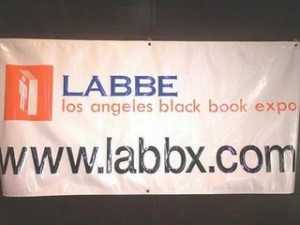
by Sandy | May 26, 2009 | Blogroll, Books, Creativity, Culture, Education, Exhibits

The Los Angeles Black Book Expo 2009 will celebrate its 5th year on 8/22/09. The day long program will feature authors, storytellers, spoken word contests and poetry performances. There will also be musicians, children’s events, panel discussions, editors, publishers, and more!
LABBX 2009
Saturday August 22, 2009 – 10 AM to 6 PM
Expo Center
3980 Menlo Ave, Los Angeles, CA
BTW – booth applications still being accepted
